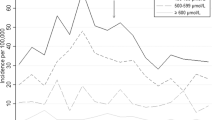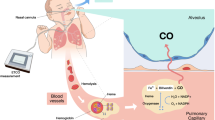Abstract
We identified four cases of hereditary spherocytosis (HS) in one Utah family, originally from Southwestern Mexico. The index cases were twin girls born at 35 weeks gestation, in whom the combination of hyperbilirubinemia, reticulocytosis and elevated mean corpuscular hemoglobin concentration (MCHC) led to studies that confirmed the diagnosis of HS. Scleral icterus in their 4-year-old sibling and in their mother led to the diagnosis of HS in them as well. Although much less commonly reported in Hispanic neonates than in those of Northern European ancestry, HS does occur among Hispanic neonates and can contribute to significant neonatal hyperbilirubinemia. These cases are consistent with our earlier report, which identified an MCHC cutoff of >36 as suggestive of further evaluation for HS.
This is a preview of subscription content, access via your institution
Access options
Subscribe to this journal
Receive 12 print issues and online access
$259.00 per year
only $21.58 per issue
Buy this article
- Purchase on Springer Link
- Instant access to full article PDF
Prices may be subject to local taxes which are calculated during checkout

Similar content being viewed by others
References
Gallager PG, Glader B . Hereditary spherocytosis, hereditary elliptocytosis, and other disorders associated with abnormalities of the erythrocyte membrane. In: Greer JP, Foerster J, Rodgers GM, Paraskevas F, Glader B, Arber DA, Means RT Jr (eds). Wintrobe's Clinical Hematology, 12th edn. Lippincott/Williams & Wilkins: Philadelphia, 2009, pp 911–920.
Perrotta S, Gallagher PG, Mohandas N . Hereditary spherocytosis. Lancet 2008; 372 (9647): 1411–1426.
Sanchez-Lopez JY, Camacho AL, Magana MT, Ibarra B, Perea FJ . Red cell membrane protein deficiencies in Mexican patients with hereditary spherocytosis. Blood Cells Mol Dis 2003; 31 (3): 357–359.
Peralta-Zagal JA, Hernández-Estrada M . Extreme hyperbilirubinemia associated with spherocytosis and choledocholithiasis. Bol Med Hosp Infant Mex 1990; 47: 43–47.
Christensen RD, Henry E . Hereditary spherocytosis in neonates with hyperbilirubinemia. Pediatrics 2010; 125 (1): 120–125.
Yetgin S, Aytac S, Gurakan F, Yuradakok M . Nonimmune hydrops fetalis in two cases of consanguineous parents and associated with hereditary spherocytosis and hemophagocytic hystiocytosis. J Perinatol 2007; 27: 252–254.
Christensen RD, Jopling J, Henry E, Wiedmeier SE . The erythrocyte indices of neonates, defined using data from over 12,000 patients in a multi hospital health care system. J Perinatol 2008; 28 (1): 24–28.
Christensen RD, Henry E, Jopling J, Wiedmeier SE . The CBC: reference ranges for neonates. Semin Perinatol 2009; 33: 3–11.
Johnson L, Bhutani VK, Karp K, Sivieri EM, Shapiro SM . Clinical report from the pilot USA kernicterus registry (1991 to 2004). J Perinatol 2009; 29 (Suppl 1): S25–S45.
Stevenson DK, Wong RJ, DeSandre GH, Vreman HJ . A primer on neonatal jaundice. Adv Pediatr 2004; 51: 263–288.
Bruce LJ, Wrong O, Toye AM, Young MT, Ogle G et al. Band 3 mutations, renal tubular acidosis and South-East Asian ovalocytosis in Malaysia and Papua New Guinea: loss of up to 95% band 3 transport in red cells. Biochem J 2000; 350, (Part 1) 41–51.
Subcommittee on Hyperbilirubinemia, American Academy of Pediatrics. Clinical practice guideline management of hyperbilirubinemia in the newborn infant 35 or more weeks of gestation. Pediatrics 2004; 114: 297–319.
Acknowledgements
We thank Diane K Lambert, RN for valuable assistance with this report.
Author information
Authors and Affiliations
Corresponding author
Ethics declarations
Competing interests
The authors declare no conflict of interest.
Rights and permissions
About this article
Cite this article
Sheffield, M., Christensen, R. Evaluating neonatal hyperbilirubinemia in late preterm Hispanic twins led to the diagnosis of hereditary spherocytosis in them, and in their sibling and in their mother. J Perinatol 31, 625–627 (2011). https://doi.org/10.1038/jp.2010.212
Received:
Revised:
Accepted:
Published:
Issue Date:
DOI: https://doi.org/10.1038/jp.2010.212
Keywords
This article is cited by
-
Evaluating eosin-5-maleimide binding as a diagnostic test for hereditary spherocytosis in newborn infants
Journal of Perinatology (2015)
-
A neonate with Coombs-negative hemolytic jaundice with spherocytes but normal erythrocyte indices: a rare case of autosomal-recessive hereditary spherocytosis due to alpha-spectrin deficiency
Journal of Perinatology (2013)



